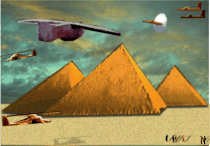Dinosaurs in Literature, Art & History--A Ceratopsian Depiction at an early 1800's Hindu Temple?...... Page 24

Click and drag photo to resize.

"The famous temple of Muktinath lies in the district of Mustang and is situated 48 km north east of Jomsom at an altitude of about 3749 meters (12,300 feet) above sea level. The temple is situated on a high mountain range and is visited during fair weather.
During the festival of Janai Purnima, Hindu devotees gather here to pay homage to lord Muktinath. The visitors get lodging facilities at Dharmasala and Maharani Pouwa. Another famous temple of Jwaladevi, the goddess of flame, is situated about hundred meters south of Muktinath.
The Muktinath Temple was consecrated in 1815 A.D by Queen Subarna Prabha, the wife of Rana Bahadur Shah. This temple is built in a Tibetan pagoda style and contains huge brass idols of Lord Vishnu, Shiva, Brahma and Kali. The local name for Muktinath is Chumig Gyatsa.
Both Hindus and Buddhists have visited Muktinath – Chumig Gyatsa for hundreds of years and this place reflects a unique blend of Hinduism and Buddhism. Muktinath geographically speaking is a high valley located on the Mustang Bhote region."
....Source: Pilgrimage Tours
On a wall of the temple are 108 "dragon headed" fountains which pilgrims seek out to "cleanse" themselves. Actually, the heads are variously described as; dragons or bulls.
At least one of the heads, as seen here on the left in this photo, is not a dragon or a bull, but instead is an excellent likeness of a ceratopsian dinosaur.

Ceratopsian Headed Fountain. One in partial black and white for contrast. Source: WIRED2THEWORLD.COM. The Jomsom Trek. Click and drag photo to resize.

The Ceratopsians
The ceratopsians first appeared in Early Cretaceous Asia and soon branched into two successful Laurasian families. The predominantly Asian Protoceratopsidae were comparatively primitive forms that were usually hornless or, at most, in possession of a small nasal horn. While staying small, they became exceedingly abundant in places like the arid plains of Mongolia.....
FURCICERATOPSIDAE
The furciceratopsids form the largest family of Asian ceratopsians, with over a dozen species, ranging from small forest dwellers to the giant megahorns. They have generalised dentition, a large narrow nasal horn or series of hornlets and prominent jugal spikes. Most have spiny or stud-like osteoderms set in their scaly hide. They tend to be unfussy feeders, eating any greenery they can easily get to.
...Indian megahorns, the largest living furciceratopsids, range from eastern India to the shores of the South China Sea. Females and young live in small herds whilst adult males are usually solitary. Their preferred habitat is grassland and open areas in forests, usually close to a watercourse where they wallow and bathe. Its powerful beak can demolish even the toughest of plants....Bowdoin.edu

Click and drag photo to resize.

Wrong About the Ceratopsians Trunk
Back on page 20, we were pretty giddy about "discovering" that the ceratopsians actually had trunks similar to that of an elephant's. However, while remaining convinced that the sculpture on page 20 represents knowledge of a living ceratopsian dinosaur, we now believe that the trunk on the animal simply reflected a penchant for artists of that region. We discovered quite a few trunked "dragons" while perusing the art of the Nepal region.
Clearly this "pre-ceratopsian discovery" dinosaur is without a trunk. The term dinosaur was coined in the mid 1800's and the first ceratopsian dinosaur fossil was "discovered", around 1872. Needless to say, the early drawings of that first ceratopsian were not nearly as accurate as is this sculptured "dragon headed" fountain at Muktinath.

1, 2, 3, 4, 5, 6, 7, 8, 9, 10
11, 12, 13, 14, 15, 16
17 18, 19,
20,
21,
22,
23,
24,
25,
26,
27,
28,
29,
30,
31,
32,
33,
34,
35,
36,
37,
38,
39,
40,
41,
42,
43,
44,
45,
46,
47
Next>>>


 Home
Home 20th Century Dinosaurs
20th Century Dinosaurs Dinosaurs in Literature, Art & History
Dinosaurs in Literature, Art & History Eyewitness Accounts
Eyewitness Accounts There Were Giants In The Earth in Those Days
There Were Giants In The Earth in Those Days Mega Fauna
Mega Fauna Those Sophisticated "Cave Men"
Those Sophisticated "Cave Men" Search for Noah's Ark
Search for Noah's Ark DNA, The Ultimate Oopart
DNA, The Ultimate Oopart The Bone Yards
The Bone Yards Underwater Cities, Monuments?
Underwater Cities, Monuments? Ancient Atomic Knowledge?
Ancient Atomic Knowledge? Salvation. What Must You Do To Be Saved?
Salvation. What Must You Do To Be Saved? Search
Search Links
Links Guestbook
Guestbook


